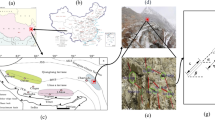Abstract
In this paper, results of numerical simulations of a repaired concrete structure are presented. A repair layer of mortar was cast on top of a substrate of old concrete. The repair mortar was staturated with water, and allowed to dry at the top surface. The moisture distribution was determined using the finite element code DIANA. The moisture gradients lead to shrinkage cracking. Using the smeared crack model available in DIANA, and from the effect of decreasing the thickness of the overlay of repair mortar (from 60 to 15 mm), and by decreasing the bond strength between repair mortar and substrate from 3 to 1 MPa, it is shown that the number of hygral shrinkage cracks depends largely on the thickness of the repair layer. Moreover, in analyses with high interfacial strength, the cracks were found to propagate into the substrate. However, at lower bond strength, debonding was observed. The analyses show that hygral strains may cause severe damage in a repaired concrete system. Problems may decrease when the overlay thickness increases or when the bond between substrate and overlay is improved. In addition, applying reinforcement in the repair layer, either as discrete bars or as distributed fibres, may decrease the spacing and width of the shrinkage cracks, thereby reducing the probability of delamination. The numerical programme is shown to be a viable tool for damage analyses not only under mechanical load, but also under hygral gradients (and thermal gradients).
Résumé
Dans cette contribution on présente les résultats de simulations numériques pour une structure en béton formée d'un vieux béton et d'une couche de mortier de réparation. Le mortier de réparation a été saturé d'eau; on en a laissé sécher la surface supérieure. La distribution hydrique a été déterminée au moyen du code DIANA à éléments finis. Les gradients hydriques résultent en une fissuration de retrait. Au moyen du modèle de la bande microfissurée de DIANA pour étudier les effets d'une diminution de l'épaisseur de la couche de mortier de réparation (de 60 à 15 mm), et d'une diminution de l'adhérence entre le mortier de réparation et le substrat de 3 à 1 MPa, il a été montré que le nombre de fissurations induites par le retrait de séchage dépend largement de l'épaisseur de la couche de matériaux de réparation. De plus, lors des analyses où il existait une forte résistance interfaciale, on a trouvé que les fissurations se propageaient dans le substrat. À de plus faibles adhérences, une décohésion a été observée. Les analyses montrent que les contraintes hydriques peuvent entraîner de graves endommagements dans un système en béton réparé. On peut les diminuer en augementant l'épaisseur de la couche de réparation ou en améliorant l'adhérence entre le substrat et le matériau de réparation. L'application de renforcement dans la couche de réparation, soit par des treillis d'armatures soit par des fibres, peut diminuer l'espacement et la largeur des fissurations de retrait, réduisant ainsi la probabilité de décohésion. On a montré que le programme numérique est un outil viable pour l'analyse des endommagements non seulement sous charge mécanique, mais également sous gradients hydriques et thermiques.
Similar content being viewed by others
References
DIANA, Users manual—Release 6.1, Diana Analysis BV, Delft, The Netherlands (1995).
Rots, J.G., ‘Computational modelling of concrete fracture’, Ph.D. thesis, Delft University of Technology, The Netherlands (1988).
Bažant, Z.P. and Oh, B.-H., ‘Crack band theory for fracture of concrete’,Mater. Struct. 16 (155) (1983).
Schlange, E. and Van Mier, J.G.M., ‘Experimental and numerical analysis of micro-mechanisms of fracture of cement-based composites’,Cem. & Conc. Composites 14 (105) (1992).
Pihalajavaara, S.E., ‘On the main features and methods of investigation of drying and related phenomena in concrete’, PhD thesis, University of Helsinki, Finland (1965).
Bažant, Z.P. and Najjar, L.J., ‘Drying of concrete as non-linear diffusion problem’,Cem. & Conc. Res. 1 (461) (1971).
Daian, J.F., ‘Processus de condensation et de transfert d'eau dans un matériau méso et macroporeux. Étude expérimentale du mortier de ciment’, Thèse de Doctorat Sciences Physiques, Université de Grenoble, France (1986).
Sakata, K., ‘A study on moisture diffusion in drying shrinkage of concrete’,Cem. & Conc. Res. 13 (216) (1983).
Wittmann, X., Sadouki, H. and Wittmann, F.H., ‘Numerical evaluation of drying test data’, Transaction 10th Int'l. Conf. on Struct. Mech. in Reactor Techn., Vol. Q (71) (1989).
Martinola, G. and Wittmann, F.H., ‘Application of fracture mechanics to optimize repair mortar systems’, in ‘Proceedings FraMCoS-2’, Wittmann, F.H., Ed., (AEDIFICATIO Publishers, Freiburg, 1995) 1481.
Alvaredo, A.M., ‘Drying shrinkage and crack formation’, PhD thesis, Institute of Building Materials, Swiss Federal Institute of Technology, Zürich, Switzerland (1994).
Van Mier, J.G.M., ‘Fracture Processes of Concrete—Assessment of Material Parameters for Fracture Models’ (CRC Press, Boca Raton, 1997).
Hillerborg, A., Modéer, M. and Petersson, P.-E., ‘Analysis of crack formation and crack growth in concrete by means of fracture mechanics and finite elements’,Cem. & Conc. Res. 6 (1996) 773.
Petersson, P.-E., ‘Crack growth and development of fracture zones in plain concrete and similar materials’, Report TVBM-1006, Lund Institute of Technology, Sweden, 1981.
Wittmann, F.H., ‘Influence of drying induced damage on the hygral diffusion coefficient’, in Proceedings FraMCoS-2, Wittmann, F.H., Ed. (AEDIFICATIO Publishers, Freiburg, (1995) 1481.
Reinhardt, H.W., ‘Fracture mechanics of an elastic softening material like concrete’,HERON 29 (2) (1984).
Elbadry, M. and Ghali, A., ‘Thermal stresses and cracking of concrete bridges’,ACI Journal 83 (6) (1986) 1001–1106.
Van Mier, J.G.M. and Vervuurt, A., ‘Lattice model for analyzing steel-concrete interface behaviour’, in ‘Mechanics of Geomaterials Interfaces’, Selvadurai, A.P.S. and Boulon, M.J., Eds. (Elsevier Science Publishers, Amsterdam, 1995) 201–225.
Zimbelmann, R., ‘A contribution to the problem of cementaggregate bond’,Cem. & Conc. Res. 15 (5) (1985) 801.
Author information
Authors and Affiliations
Additional information
Editorial note: Dr. Jan G. M. van Mier is a RILEM Senior Member. He is Secretary of TC 148-SSC on Test methods for the Strain Softening responses of Concrete and a member of TC 159-ETC on Engineering of the interfacial Transtion zone in Cementitious composites. In 1987, Dr. van Mier was awarded the Robert L'Hermite Medal for outstanding research work. Dr. van Mier is also a member of the RILEM Management Advisory Committee.
Rights and permissions
About this article
Cite this article
Sadouki, H., van Mier, J.G.M. Simulation of hygral crack growth in concrete repair systems. Mat. Struct. 30, 518–526 (1997). https://doi.org/10.1007/BF02486395
Received:
Accepted:
Published:
Issue Date:
DOI: https://doi.org/10.1007/BF02486395




